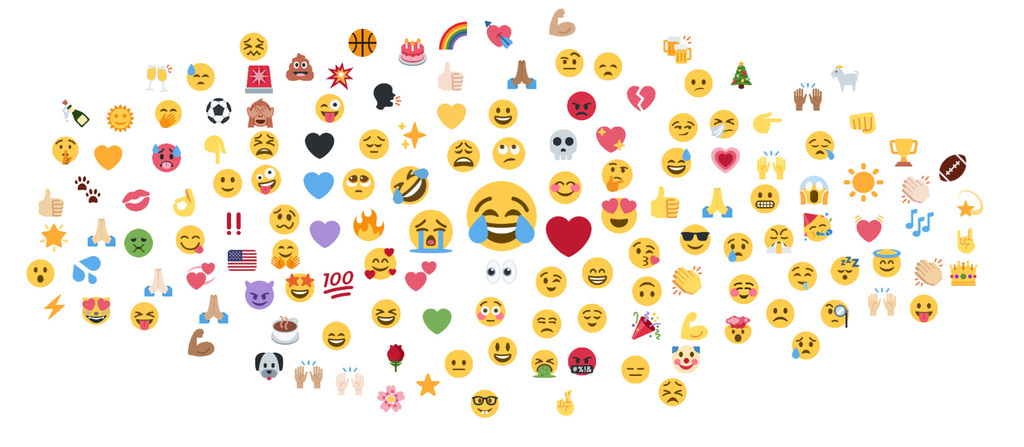Report
Global Emotions Report 2020
When we understand the emotions of our customers, we can better cater to their needs. What does the emotional landscape look like online? And what industries/brands come out on top?
Learn more about emotion analysisNavigating emotions effectively is an important part of any healthy relationship.
When your partner is mad, you should be able to recognise the signs and (hopefully) fix the situation. When your best friend is excited, you should sense this and build on the joy with them!
The same logic applies to brands and their customers. When we understand customers’ emotions, we can better serve their needs and become more Consumer Fit.
How can we use online data to track this?
- Emojis are fun to use and add a little flavor to any message, but they also provide a lot of insight on how the writer feels. We’re able to track how emojis are used online using Brandwatch Consumer Research.
- Emotions analysis is a good way to track how people are feeling, and Consumer Research is able to automatically segment online mentions by emotion.
Emotions data should inform your business strategies, from marketing campaigns through to product launches. The trick is to understand how to uncover, analyze, and then leverage this information. We’re here to help with that.
In this report we’ll cover:
1. Top-used emojis
Emojis can pack a lot of punch. They’re how we show our feelings. Whether someone made us crack up laughing 😂, or we’re showing our love for a dear friend ❤️, these little graphics are always meaningful.
With Brandwatch Consumer Research, we analyzed public tweets in English back to January 2019. The tweets had to contain at least one emoji, and we searched within the following locations: Australia, France, Germany, Mexico, Singapore, Spain, UK, and USA.
- Top 3 emojis: 😂, 😭, ❤️
- Top 5 emojis from female authors: 😂, ❤️, 😭, 😍, 🤣
- Top 5 emojis from male authors: 😂, 🤣, 😭, ❤️, 👍
In all of the locations we analyzed the 😂 is number 1. However, we did uncover some interesting regional differences:
- The 😍 is in second place in Germany, Mexico and Spain.
- 😭 comes in second place in France and US.
- The purple heart 💜 is popular in Mexico, Singapore and Spain – mostly from fans of BTS.
- Our pals from Australia have the most positive emojis in their top 10.
- The most negative emojis are used by the US (😭,😩,🙄, 🤔).
2. The emotions we share online
Encouragingly, over half of the emotion-categorized tweets we studied were joyful.
These were followed by sad and angry tweets, showing that Twitter really does bring out the full spectrum of emotions.
When it came to the joyful conversations, phrases like ‘love’, ‘happy’, and ‘good’ were used most frequently, often with people mentioning others to wish them a happy birthday or to compliment them on a job well done. Overall, the people most associated with positive tweets were family and friends. Somewhat unsurprisingly, Christmas was the most joyful event in the Twitter world 🎄.
Work is often mentioned in an angry context, which brings up an important point about employee advocacy. When people see employees disgruntled with their company, it can affect consumer’s perception of the brand as a whole.
Sad conversations are usually about missing loved ones or public figures that are acting in a way that elicits sorrow.
When it comes to fear, we hear a lot about ‘tomorrow’, whether that’s in the context of an upcoming exam or a job interview.
Emotions by demographics and location
Emotions aren’t one-size-fits-all. You can get a quick glimpse at how this is by using demographics analysis.
Typically, female authors showcase more joy and sadness online than their male counterparts. Men tend to express more surprise than women. Surprise is also more prevalent in people that like sports as they comment on shocking victories and moves during games.
IT professionals showcase a bit more anger and fear than other professions, while students show more sadness. Legal professionals show more disgust, and teachers are the most likely to express joy.
There are some interesting emotional differences based on region as well. We found that:
- The most joyful audience is in Germany.
- The most negative audience is in the US.
- Singapore has the highest percentage of angry and disgusted tweets.
- The UK audience has the most fear-based conversation.
3. Events in 2019 that made us emotional
Every year, we see a handful of events that spark hugely emotional conversations online. In 2019, we had some standard contenders and some outliers.
Overall, Christmas was the most joyful event of the year as it spread joy steadily over a period of time. However, the day that caused the highest peaks in joyful conversations was Valentine’s Day, followed by Christmas, Thanksgiving, and New Year’s Eve.
The most surprising event was the Champions League semifinal. The surprise was largely due to the fact that in an international tournament, two English teams came out on top.
Halloween was the most “fearful” event, due to the spooky nature of the holiday. In fact, people began to chat about spooky Halloween ideas in early October!
Angry tweets were pretty consistent over the year, but the events that caused the highest peaks were when social media platforms went down and the people complained on Twitter (for example, on March 13 and July 3, Instagram and Facebook were down).
Political events tended to cause the highest peaks in disgusted conversation.
Positive vs. negative: What people liked and disliked
Although December sparked a lot of joyful conversations around Christmas and New Year’s Eve, it was also the month with the most negative sentiment (mainly caused by big political event sin the US and the UK).
The highest percentage of positive conversations was in February. Valentines Day sparked a lot of conversation about love and people took to Twitter to express how grateful they were for all the types of love in their lives.
4. Sectors and emotions
People feel the most joyful about retail and fashion. For fashion, the highest peak in joyful conversation was caused by the #MyCalvins campaign that included Shawn Mendes and Kendall Jenner.
It turns out consumers are way more angry about telecommunication brands than other industries. This stems from online complaints about outages and poor customer service.
The consumer packaged goods (CPG) sector has the most disgusted mentions. Aside from conversation about food people hate or that made them sick, the somewhat polarizing Gillette #BestMen campaign resulted in a lot of conversations that tipped the scale towards concern.
TV and restaurants make people more sad than other industry counterparts. TV shows unleash all kinds of emotions for the viewer, and streaming platforms were a source of sadness due to show cancellations.
In terms of restaurants, Olive Garden faced a particular peak of sad mentions on Twitter after rumors spread that they were donating to Trump’s reelection campaign. These claims turned out to be false.
There were some notable differences in emotional conversation around sectors, depending on the region. Here are a few highlights:
- In comparison to the other analyzed locations, people in Mexico and Spain are the happiest and least angry with brands.
- People in Australia feel more disgust and fear around brands than people from other locations.
- People in France and Germany were less likely to feel sad about brands than consumers in other countries.
5. What brands make people happy?
Which brands manage to spark the most joy?
Notably, there are a lot of retailers and entertainment providers listed here. It seems like TV binges and custom-made goods are bringing joy to the front of the conversation.
| Rank | Brand |
|---|---|
| 1 | Amazon |
| 2 | Etsy |
| 3 | Ebay |
| 4 | Paypal |
| 5 | MTV |
| 6 | Tesla |
| 7 | Nike |
| 8 | Chanel |
| 9 | Microsoft |
| 10 | Nintendo |
Let’s take a closer look at the top three.
1) Amazon
Amazon mostly profits from joyful conversations around giveaways with Amazon gift cards or people donating items from Amazon wishlists to non-profits or charities.
2) Etsy
Etsy’s community of creators and fans of handmade unique products are vocal about their joy around certain items. Creators often take to social to thank their loyal customers.
3) eBay
This brand is no stranger to happy chatter. We see a lot of people expressing joy when they win an auction or find that perfect item!
While the above three brands tend to spark a lot of positive conversations across the board, there were some key differences depending on region:
- Amazon is number 1 in Australia, UK, and USA, but in all the other analyzed countries Etsy is top.
- People in France love their designers, with Chanel and Dior in the top 10
Porsche causes the most joy for German people. - MTV is popular in Mexico and Spain (fourth spot).
- TV networks score in the UK with ITV, BBC 1, and Channel 4 all in the top 10.
- Qantas ranks 8 in Australia and Singapore Airlines ranks 11 in Singapore.
6. What can brands learn from these insights?
From the data we just explored we can draw a few important lessons.
1) Tracking emotions can present buying opportunities
When we identify consumer emotions, we can better connect with our customers. These connections are often the difference between a highly-connected brand ambassador and a satisfied customer, and can result in more valuable relationships.
In fact, research conducted by Harvard Business review found that fully connected customers are over 50% more valuable than those who are just highly satisfied. These fully-connected clients account for 37% of revenue and spent, on average, twice as much annually as highly satisfied customers.
2) Understanding your customers is good for business
Numbers aside, understanding your customers on a deeper level is just flat-out good business practice. When you see that your audience is excited about the reboot their favorite show, you can better connect to them by understanding that importance and creating content around it.
When a right-wing leader makes them upset, you know that brand affiliations with those politics will not go over well. The insights gained from understanding feelings can make a huge difference.
Emotions are the gateway to being truly Consumer Fit. Do you know how your customers feel?
Methodology
With Brandwatch Consumer Research we analyzed public tweets in English from 1. Jan – 31. Dec 2019, containing at least one emoji and from the following locations: Australia, France, Germany, Mexico, Singapore, Spain, UK, and USA. We analyzed popular emojis (over 1580 different emojis in total, except flags, objects, and symbols).
Scope: For the analysis we took a statistically significant 1% sample of Twitter (8.62 million from 889 million tweets). Volumes in charts show the true volume – the sampled number x 100.
Emotion analysis: Brandwatch automatically assigns emotions to each mention in our system, using classifiers created in-house by our Data Science team, and based on the six basic emotion groups made popular by the famous psychologist Paul Ekman: Anger, disgust, fear, joy, surprise, and sadness.
Demographic analysis: Brandwatch uses a vast database of names to understand the gender of the person behind an account. Where the algorithm isn’t sure, it doesn’t add categorize an account as belonging to someone of a particular gender. To identify author interests and affinities, an algorithm analyzes the people and organizations individuals engage with and their discussion topics.
Brands and sector analysis: The studied brands and sectors are based on the Brandwatch Index ranking. Online conversations from over 600 brands from 13 sectors were analyzed.
Comparison to last year’s report: As we did not use the same methodology as in the last year’s emotion report, we do not advise people to compare the results.

